The electric power supply is generally brought into your home from your local utility using electrical cables & is finished at the distribution box with CBs or circuit breakers. To utilize this electric supply, it is distributed all over the house either through external conduits or in-wall & reaches light bulb connectors as well as electrical outlets. An Electrical Outlet is also known as an electrical receptacle and is the main power source within your home. To power up the appliance or device, the device plug needs to be inserted into the electrical outlet & turn it ON. This article provides brief information on an electrical outlet, working, types, circuit working, and its advantages.
What is an Electrical Outlet?
An electrical outlet (or) wall outlet or receptacle is a socket that is used to connect an electrical device to a current supply. These devices are usually installed in the walls of buildings and rarely, these can be found in the ceiling for powering devices like neon signs or garage door openers within storefront windows. Electrical outlets are available with a minimum of one to three receptacles wherever single or three devices can be connected. There are different kinds of electrical outlets which vary based on the country’s voltages. Electrical outlets are small in size but most significant devices in homes, industries, and business areas. These devices are also very important in most household electronics like; televisions, lighting systems & computers.
Electrical Outlet Parts Diagram
The electrical outlet includes different parts each part and its function is discussed below.
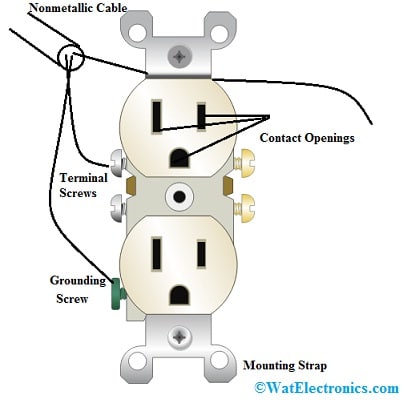
Electrical Outlet Parts Diagram
Mounting Strap
The mounting strap is located at the bottom of the outlet. This strap includes a metal piece with two holes. Once screws are arranged within the holes, then it keeps the receptacle in place so it remains level through the outside of the box.
Nonmetallic Cable
A nonmetallic cable (Romex) is made with a plastic jacket that contains white, black & bare copper wires which are connected to a circuit-breaker panel.
Contact Opening
The areas on the receptacle of the outlet are known as contact openings which are useful for inserting electrical plugs. Generally, contact openings are available in different sizes and shapes based on the outlet type, the amount of voltage amount, and the country.
Terminal Screws
The terminal screws are the safest points for wire connection which are located beside the receptacle which helps in protecting the wires. These screws are silver screws and brass screws. The silver screw is used to connect the white wires whereas the brass screw is used to connect the black wire. Connecting wires to the suitable screw is very important otherwise they can cause electrical shock or short circuit.
Grounding Screw
The grounding screw is connected at the bottom to the side of the receptacle. This screw helps in connecting the bare copper grounding wire so that it helps in preventing electric shocks.
Working
An electrical outlet is the electrical power source that is used to plug in various appliances. The electrical outlet works as; at first, electricity is brought to your home through a power plant & power lines. So this power is brought into your home & it can be distributed by a CB (circuit breaker). This CB is connected to each of your outlets through wiring.
Electrical output includes three holes where the left hole is neutral, the right hole is hot and the third hole is the GND. The left hole is simply connected to the electrical wire that gets the current supply back to the breaker box and the right hole is connected simply to the electric wire to supply the current. Whenever you connect a lamp & switch it on, the right hole of the electrical outlet simply allows the current supply to flow into the lamp to turn ON the light bulb.
The circuit is finished whenever the current supply is brought back into the electrical outlet throughout the neutral slot & back into the CB. Whenever you unplug the lamp the circuit will be broken, so the lamp stops working. A circuit breaker is a protection device used to break or trip a circuit if the current supply is very high. Another safety system of electrical systems for homes is having grounded outlets/grounded wires.
Electrical Outlet Wiring Diagram
Electrical outlet wiring with a switch diagram is shown below. So in this wiring diagram, a switch is connected to an existing electrical outlet by simply eliminating the hot wire from the outlet brass terminal & connecting to the primary switch terminal. After that, the next terminal of the switch is connected back to the outlet’s brass terminal. In this manner, the electric outlet is wired & controlled through the switch by turning it ON/OFF.
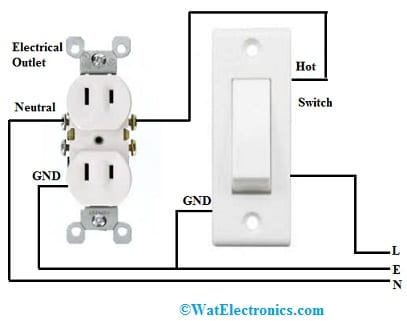
Electrical Outlet Wiring
AC Power Electrical Outlet with Timer
Generally, turning off any home appliance is very important when it is not used in order to save money & energy. Here is a simple circuit designed to turn ON or OFF home appliances automatically at a specific time using an AC power socket and IC555 timer. It is used to control your home’s lighting, air conditioning & heating.
The required components to make this circuit mainly include; IC NE555 Timer, 1N4007 Bride Rectifier Diode, BT136 TRIAC, 9V Zener Diode, Green LED, two 470uf electrolyte capacitors, 100nF ceramic capacitor and resistors 2.2M, 100 Ohm, 47K and 2.2K. Connect the circuit as per the diagram shown below.
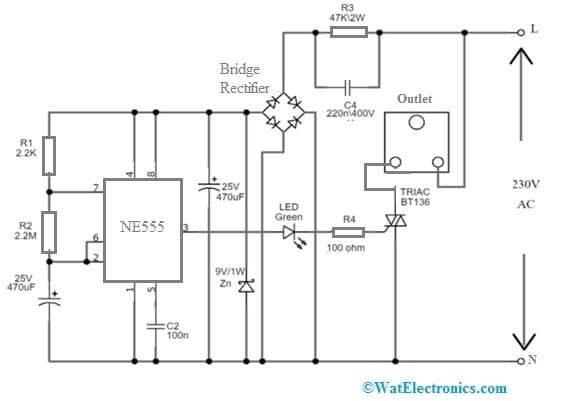
AC Power Electrical Outlet with NE555 Timer
Working
This AC power electrical outlet with a timer circuit uses AC mains power mainly for the AC plug point. Whenever there is no power supply, then the X-rated C4 capacitor and R3 resistor decrease the power supply throughout capacitive reactance & the R3 resistor discharges the power supply across the capacitor.
In this circuit, the bridge rectifier changes AC to DC, the ZD1 Zener diode changes the DC supply to keep it stable near 9V. At last, the capacitor ‘C3’ filters the power supply. The time delay in the timer circuit can be adjusted by changing simply the C1 capacitor & R2 resistor values. This circuit uses 555 IC that works as an astable multivibrator to make long-duration timing pulses.
The BT136 TRIAC in this circuit is connected between both the AC socket & the GND. The gate terminal of this TRIAC is linked to the output pin of 555 IC. Once the high pulse increases, TRIAC will turn on & make the power supply accessible at the electrical outlet for a particular amount of time. When the low pulse is received from the 555 timer IC, the TRIAC will turn off, so there is no available power supply at the outlet. In this way, we can create any electrical device to turn ON & OFF frequently. This circuit is a very good choice in controlling the appliances & also saves electricity.
Electrical Outlet Types
There are different types of electrical outlets which are discussed below.
15A 120V Outlet
15A 120V outlet is one of the most frequently used types of outlets that are suitable for 120VAC supply with 15A of maximum current draw. These outlets include 14-gauge wire which is protected through a 15A breaker. These outlets are cheap, very easy to connect and also replace. The applications of these outlets range from small-powered to medium-powered devices like laptop chargers, PCs, smartphone chargers, desktops, and many more. These outlets are suitable for home lights which have minimum amperage & voltage requirements.
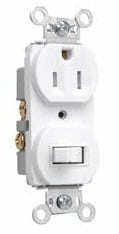
15A 120V Outlet
20A 120V Outlet
20A 120V outlets are used commonly in the U.S. which work with 250VAC supply & it draw 20A maximum current. The receptacle of this outlet is different slightly as compared to the 15A outlet with the tiny horizontal slot. In addition, these outlets use a 10-gauge/12-gauge wire through a 20A breaker. These are used in little powerful appliances like microwave ovens.
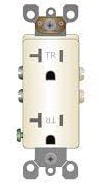
20A 120V Outlet
20A 250V Outlet
The 20A 250V outlet works with 250VAC supply and it draws 20A of maximum current. These outlets are used in powerful appliances like; large ovens, electric stoves, etc, and also used in large appliances like; air compressors, air conditioners, etc. These outlets include a minimum of three (or) four prongs and it need a double-pole CB which needs to be connected to the main electrical panel. This circuit breaker uses two slots on the electrical panel which is fed through two bus bars.
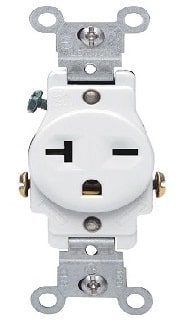
20A 250V Outlet
30A 250V Outlet
The 30A 250V outlet uses a 250VAC supply and draws a maximum 30A of current. These outlets are applicable in powerful appliances like air compressors, air conditioners, welding equipment, and many more.
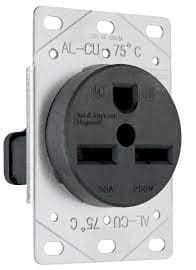
30A 250V Outlet
GFCI Outlet
In GFCI Outlet, the term GFCI stands for “Ground-Fault Circuit Interrupter” which is used usually where the place can be potentially wet like in bathrooms, kitchens, crawlspaces, basements, laundry areas, etc. These types of outlets simply guard against ground faults by monitoring the flow of current throughout the neutral & hot wires. If the flow of current within both the electric wires is not similar, then there is a current leak to the GND & this outlet trips immediately. Generally, this outlet helps in detecting 5mA of the current difference.
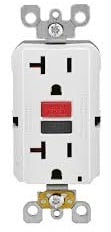
GFCI
AFCI Outlet
In AFCI Outlet, the term AFCI stands for “Arc-Fault Circuit Interrupters”. Generally, some electrical faults generate heat throughout the arcing. Whenever this arcing occurs, the AFCI outlet detects it & the integrated circuit breaker will deactivate the AFCI Outlet. In electrical systems, arcing occurs in loose contact points where the electricity moves in between connections.
The AFCI outlet is another security outlet that has a computer that monitors the current & voltage continuously. If there are arcs because of loose wires or broken wires then AFCI trips the solenoid and opens the circuit. This outlet prevents fires that are normally caused by arc faults. These outlets prevent electrical hazards within bedrooms, laundry areas & kitchens.
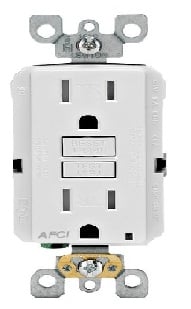
AFCI
Tamper Resistant Receptacle
Tamper-resistant receptacle outlets are generally used in modern buildings which are marked normally as “TR”. These outlets have an in-built barrier that avoids insertion of objects except plugs by ground prong (or) suitable two-pin pronged plugs. These outlets are very safe even if you add anything except a proper plug.
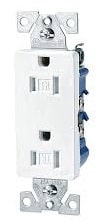
Tamper Resistant Receptacle
Weather Resistant Receptacle
Weather resistant receptacle outlet is designed normally with a corrosion-resistant material & also with a weather-protective cover. These outlets are normally available in 20A & 15A configurations. These kinds of outlets are used in outdoor conditions & they provide protection from dirt, rain, moisture, humidity & ice snow.
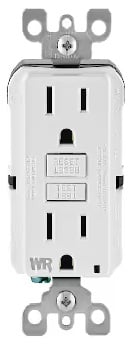
Weather Resistant Receptacle
Rotating Outlet
A Rotating outlet rotates with 360 degrees. This outlet is very handy if you have several outlets & a large adapter blocks the next outlet. The second outlet can free up when the first outlet is simply rotated. When rotating outlets are installed on the walls bulky chargers won’t clutter outlets anymore. These innovative outlets cater properly to your new lifestyle by turning 360 degrees thus you can virtually plug in anything without blocking the second outlet.
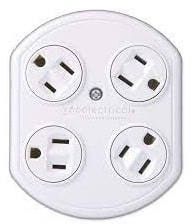
Rotating Outlet
Ungrounded Outlets
These types of electric outlets include two slots only; hot & neutral. Generally, most of the electrical outlets are three-pronged, where the last slot acts as a grounding connector. The ground terminal of this outlet simply provides an alternative lane to allow the flow of electricity if there is an issue with the usual path.

Ungrounded Outlet
USB Outlets
USB wall outlets in households today are used to charge tablets, power banks, and smartphones via USB. These outlets have a minimum one or above USB sockets located on your wall directly. USB outlets are available in two basic types one type of outlet includes the main 15A outlet through additional USB connectors whereas the other type includes all USB connectors exclusive of any regular household receptacles.
These outlets are very famous because you don’t have to bother about chargers & plug in the cable simply into the USB port on the electrical outlet to charge your phones.
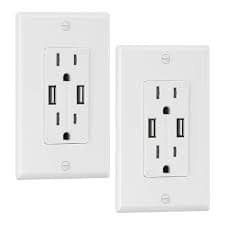
USB Type
Smart Outlets
Smart outlets are very innovative and that has a built-in feature that helps in monitoring the usage of power. These outlets can also switch ON/OFF any schedule. So these outlets are great if you desire to run on a fixed schedule such as; drip coffee makers, lawn sprinklers, etc. These outlets help in avoiding leakage of power & help in making your home more efficient. Many smart outlets have remote control features with Wi-Fi, Zwave protocols, or Zigbee so that one can operate & track remotely using your phone (or) with voice assistants.
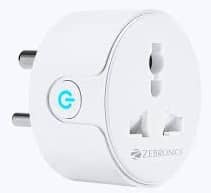
Smart Outlet
Advantages and Disadvantages
The advantages of an electrical outlet include the following.
- The electrical outlet is capable of turning off power to a particular outlet which is used to control the usage of power or turning off devices whenever they are not in use.
- It disconnects the power supply to a specific outlet very quickly when a potential electrical hazard occurs.
- The switch with this outlet is used as a safety feature because it allows you to disconnect power easily to a particular outlet if you observe something wrong like a burning smell or sparking.
- It is very convenient to disconnect all power supplies immediately.
- It provides high security.
- It is very convenient to turn it off.
The disadvantages of electrical outlets include the following.
- The electrical outlet with the added switch component will make the socket more costly as compared to a standard outlet.
- The switch of the outlet may be prone to corrosion over time, so it needs repairs or replacement.
- The switch could be turned off accidentally so that it disconnects the power supply to the connected device into the electrical outlet.
- There is a current supply still within the socket.
- It generates electric sparks easily.
- Children must pay more attention to electric safety.
What Outlet is used for Electrical Applications?
Type D type outlet is rated at 5A which is used widely in India, Namibia, Nepal & Sri Lanka. It is an unpolarized & ungrounded plug including two round pins.
What Are Electrical Outlets Used For?
Electrical outlets are available in two primary types; domestic & industrial which allow electrical equipment to attach to the electrical grid. The electrical grid supplies AC to the outlet.
What are the two Common Outlets used at Home?
The two common outlets used at home are; 15A, 120 Volt Outlets, 20A, and 125 Volt Outlets. …
What are the Three Holes in an Outlet?
The first hole (left hole) is neutral, the second hole (right hole) is hot and the third hole is the GND hole.
Can a Bad Outlet Cause Other Outlets Not to Work?
A bad outlet doesn’t affect any other outlets always but sometimes it may affect the circuit breaker to trip, so that it results in the other outlets not working as well.
Thus, this is brief information on an electrical outlet which is also called with different names like; electrical receptacles, wall sockets, and outlets. These outlets accept plugs & supply electric current supply to run different electrical devices. These outlets are applicable in different general-purpose, residential, commercial, laboratory, hospital & industrial applications. Here is a question for you, what is a switched outlet?